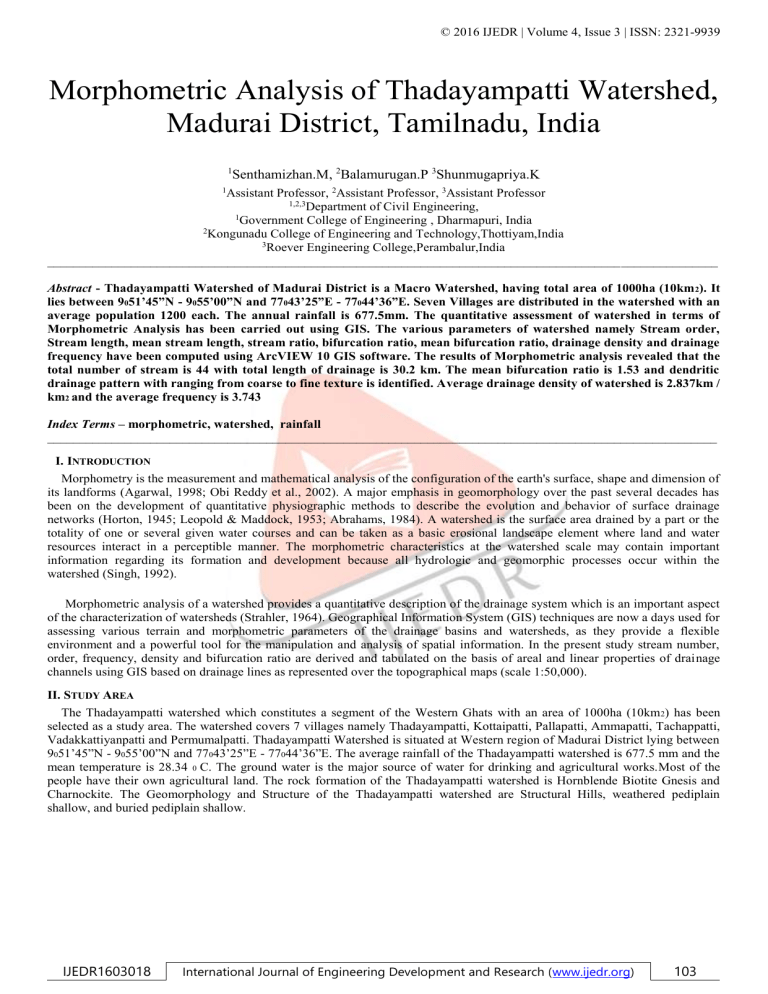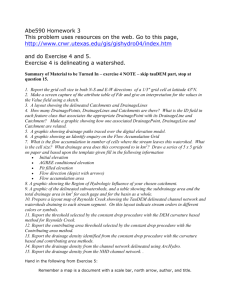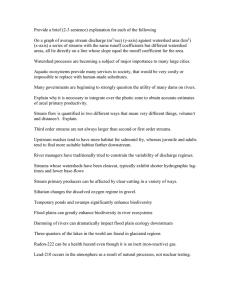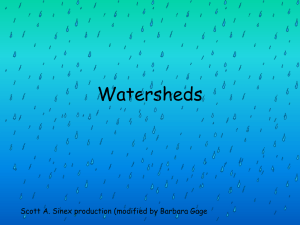
© 2016 IJEDR | Volume 4, Issue 3 | ISSN: 2321-9939 Morphometric Analysis of Thadayampatti Watershed, Madurai District, Tamilnadu, India 1 Senthamizhan.M, 2Balamurugan.P 3Shunmugapriya.K 1 Assistant Professor, 2Assistant Professor, 3Assistant Professor 1,2,3 Department of Civil Engineering, 1 Government College of Engineering , Dharmapuri, India 2 Kongunadu College of Engineering and Technology,Thottiyam,India 3 Roever Engineering College,Perambalur,India ________________________________________________________________________________________________________ Abstract - Thadayampatti Watershed of Madurai District is a Macro Watershed, having total area of 1000ha (10km 2). It lies between 9051’45”N - 9055’00”N and 77043’25”E - 77044’36”E. Seven Villages are distributed in the watershed with an average population 1200 each. The annual rainfall is 677.5mm. The quantitative assessment of watershed in terms of Morphometric Analysis has been carried out using GIS. The various parameters of watershed namely Stream order, Stream length, mean stream length, stream ratio, bifurcation ratio, mean bifurcation ratio, drainage density and drainage frequency have been computed using ArcVIEW 10 GIS software. The results of Morphometric analysis revealed that the total number of stream is 44 with total length of drainage is 30.2 km. The mean bifurcation ratio is 1.53 and dendritic drainage pattern with ranging from coarse to fine texture is identified. Average drainage density of watershed is 2.837km / km2 and the average frequency is 3.743 Index Terms – morphometric, watershed, rainfall ________________________________________________________________________________________________________ I. INTRODUCTION Morphometry is the measurement and mathematical analysis of the configuration of the earth's surface, shape and dimension of its landforms (Agarwal, 1998; Obi Reddy et al., 2002). A major emphasis in geomorphology over the past several decades has been on the development of quantitative physiographic methods to describe the evolution and behavior of surface drainage networks (Horton, 1945; Leopold & Maddock, 1953; Abrahams, 1984). A watershed is the surface area drained by a part or the totality of one or several given water courses and can be taken as a basic erosional landscape element where land and water resources interact in a perceptible manner. The morphometric characteristics at the watershed scale may contain important information regarding its formation and development because all hydrologic and geomorphic processes occur within the watershed (Singh, 1992). Morphometric analysis of a watershed provides a quantitative description of the drainage system which is an important aspect of the characterization of watersheds (Strahler, 1964). Geographical Information System (GIS) techniques are now a days used for assessing various terrain and morphometric parameters of the drainage basins and watersheds, as they provide a flexible environment and a powerful tool for the manipulation and analysis of spatial information. In the present study stream number, order, frequency, density and bifurcation ratio are derived and tabulated on the basis of areal and linear properties of drainage channels using GIS based on drainage lines as represented over the topographical maps (scale 1:50,000). II. STUDY AREA The Thadayampatti watershed which constitutes a segment of the Western Ghats with an area of 1000ha (10km 2) has been selected as a study area. The watershed covers 7 villages namely Thadayampatti, Kottaipatti, Pallapatti, Ammapatti, Tachappatti, Vadakkattiyanpatti and Permumalpatti. Thadayampatti Watershed is situated at Western region of Madurai District lying between 9051’45”N - 9055’00”N and 77043’25”E - 77044’36”E. The average rainfall of the Thadayampatti watershed is 677.5 mm and the mean temperature is 28.34 0 C. The ground water is the major source of water for drinking and agricultural works.Most of the people have their own agricultural land. The rock formation of the Thadayampatti watershed is Hornblende Biotite Gnesis and Charnockite. The Geomorphology and Structure of the Thadayampatti watershed are Structural Hills, weathered pediplain shallow, and buried pediplain shallow. IJEDR1603018 International Journal of Engineering Development and Research (www.ijedr.org) 103 © 2016 IJEDR | Volume 4, Issue 3 | ISSN: 2321-9939 Figure 1 Study Area III. METHODOLOGY Morphometric analysis of a drainage system requires delineation of all existing streams. The stream delineation was done digitally in GIS (Arcview10) system. All tributaries of different extents and patterns were digitized from survey of India toposheets 2011 (1:50,000 scale) and the catchment boundary was also determined for Thadayampatti drainage. Similarly, watershed consisting of 3 watersheds were also delineated and measured for intensive study. Digitization work was carried out for entire analysis of drainage morphometry. The different morphometric parameters have been determined. The Parameters are Stream length [Horton (1945)], stream order [Strahler (1964)], mean stream length [Strahler (1964)], stream length ratio, bifurcation ratio [Schumn (1956)], mean bifurcation ratio [Strahler (1957)], Drainage density [Horton (1932)], drainage frequency[Horton (1932)]. IV. RESULTS AND DISCUSSION The various parameters for morphometric analysis have been computed and they are interpreted as follows: Figure 2 Three Macro Watershed of Thadayampatti Digitizing using Vector Data Model IJEDR1603018 International Journal of Engineering Development and Research (www.ijedr.org) 104 © 2016 IJEDR | Volume 4, Issue 3 | ISSN: 2321-9939 Stream Order (Nu) Stream order of the drainage basin is the successive assimilation of the streams within a drainage basin. There are varieties of methods to determine the stream order. Many authors have defined the calculation of Stream Order [Horton (1945), Strahler (1952)]. According to the Strahler's (1952) method stream ordering of Thadayampatti drainage has been adopted and carried out. The entire basin has first order to fourth order streams that reveal medium developed dendritic type drainage network Table 1 Stream Order Name / Order I II III IV Total 23 6 2 1 WS1 32 6 2 1 WS2 9 2 1 WS3 3 Total 31 9 3 1 44 Individual counting of the streams in the river basin reveals the total number of the streams. According to the stream number of streams in a watershed can easily be segregated and measured. The entire Thadayampatti drainage basin has total of 44 streams. The maximum number of streams 32 is found in watershed 1 (WS1) and the minimum number of streams 3 is found in watershed 3 (WS3). Among the 2 watershed, the WS1 has produced more tributaries indicating good runoff characteristics of soil. The bilinear diagram has been drawn using Excel Sheet to indicate correlation between stream order and stream length. It shows that the stream number decreases when the stream order increases Figure 3 Relation between Stream Order and Stream Number Stream Length (Lu) Stream length of river can be measured with help of Arc GIS10 Software, from the respected SOI toposheet of the drainage basin. It is prevailed that the total length of the streams in entire basin is 30.2km. Among the tributaries of the drainage WS1 has highest stream length i.e. 21.15km, whereas WS3 has 3.15km. Table 2 Stream Length Name / Order WS1 WS2 WS3 Total I 12.25 3.15 0.8 16.2 II 3.5 0.35 2.35 6.2 III 0.75 2.4 3.15 IV 4.65 4.65 Total 21.15 5.9 3.15 30.2 Stream Length Ratio(RL) The ratio in-between the average lengths of streams of successive orders is stream length ratio. Stream length ratio obtained by Horton (1945) equation. RL = Lu / Lu – 1 (1) Where 'RL' = Stream length ratio Lu = the mean stream length of all stream segments of the order 'u' Lu-1 = the mean length of all stream segments of next lower order. Table 3 Stream Length Ratio Stream Order I/II II/III III/IV 3.35 4.67 0.16 WS1 9 0.15 0 WS2 0.34 0 0 WS3 Total 12.69 4.82 0.16 IJEDR1603018 International Journal of Engineering Development and Research (www.ijedr.org) 105 © 2016 IJEDR | Volume 4, Issue 3 | ISSN: 2321-9939 Mean Stream Length (Lsm) Lsm = Lu / Nu (2) Lu = Stream Length Nu = Total number of stream Segments in Order. Name First order Second order Third order Fourth order Table 4 Mean Stream Length Stream Length Number of Stream 16.2 31 6.2 9 3.15 3 4.65 1 Lsm 0.54 0.69 1.05 4.65 Bifurcation Ratio (Rb) According to Schumm (1956) 'bifurcation ratio' is the ratio between the total numbers of steams of one order to that of the next higher order. Rb = Nu / Nu + 1 (3) Where 'Rb' = Bifurcation ratio Nu = Number of segments of a given order 'u' Nu+1 = Number of segment of next higher order. Bifurcation ratio is dominated by drainage density which again controlled by land configuration e.g. rock structure, basin shape etc Table 5 Bifurcation Ratio Name WS1 WS2 WS3 3.28 2 1 I/II 2 1 0 II/III 1 0 0 III/IV Average 2.09 1.5 1 The Rb ratio is ranging between 1.0 and 2.09. Rb ratio is used to interpret structural deformity of watershed area. The higher value of Rb would indicate strong structural control of watershed for stream characteristics. In the study area the Thadayampatti watershed has Rb value which is much lesser ranging from 1.0 to 2.09 and it implies the watershed is less affected by structural deformity of lithology of the watershed. Hence the stream characterization of the Thadayampatti watershed is depending on topography of the area. Mean Bifurcation Ratio (Rbm) Table 6 Mean Bifurcation Ratio Name Average 2.09 WS1 1.5 WS2 1 WS3 Mean Value 1.53 Drainage Density (Dd) Drainage Density (Du) Drainage density can be defined as a ratio of total length of all stream to the total area of the same basin. According to Strahler (1952) Dd = T L / A (4) Where, Dd = Drainage density TL= Total lengths of all streams in basin. A = Total area of basin Drainage density is the length of stream per unit area say for example square kilometer. Drainage density is an indicator of the terrain configuration that is rocks property and some time vegetative wrap over the land. Table 7 Drainage Density Name Total Length Area WS3 Km2 21.15 5.8 3.64 WS1 5.9 3.15 1.87 WS2 3.15 1.05 3 WS3 In the instance of the Thadayampatti drainage basin the average density is 2.837 km/ km² which is an indicator of impermeability of the rocks beneath in the entire basin WS1 has maximum density i.e. 3.64 km/ km² which is a symptom of well developed drainage with undulating topography. On the other hand WS2 has lowest density of 1.87 km/ km² owing to passing through flat terrain of well developed regolith. IJEDR1603018 International Journal of Engineering Development and Research (www.ijedr.org) 106 © 2016 IJEDR | Volume 4, Issue 3 | ISSN: 2321-9939 Drainage Frequency (FU) The drainage frequency senses the number of stream segments in per unit area. It is a good indicator of the drainage pattern. Drainage frequency has duly been obtained by the total number of streams divided by the total area in km² Table 8 Drainage Frequency Name Total Number Area Frequency of Stream Km2 32 5.8 5.51 WS1 9 3.15 2.86 WS2 3 1.05 2.86 WS3 The poor to high (2.86 to 5.51) frequency value for Thadayampatti watershed is attributed to agricultural land use pattern followed in the watershed and elongated drainage controlled by ridges of the watershed. It also indicates more than 50% area of Thadayampatti watershed are falling higher drainage frequency. IV. CONCLUSION The drainage basin is selected as an ideal geomorphological unit. Watershed as a basic unit of morphometric analysis has gained importance because of its topographic and hydrological unity. GIS techniques characterized by very high accuracy of mapping and measurement prove to be a competent tool in morphometric analysis. Drainage density and stream frequency are the most useful criterion for the morphometric classification of drainage basins which certainly control the runoff pattern, sediment yield and other hydrological parameters of the drainage basin. In the study area the Thadayampatti watershed has Rb value which is much lesser ranging from 1.0 to 2.09 and it implies the watershed is less affected by structural deformity of lithology of the watershed. Hence the stream characterization of the Thadayampatti watershed is depending on topography of the area. The Drainage density appears significantly higher in WS1 watershed implying the existence of impermeable rocks and high relief. It is observed that there is a decrease in stream frequency as the stream order increases. The law of lower the order higher the number of streams is implied throughout the catchment The total length of stream segments is maximum in first order streams and decreases as the stream order increases. The study has shown that the catchment is in conformity with the Hoton’s law of stream numbers and law of stream lengths. The same geological and lithological development of the catchment has resulted into more or less constant bifurcation ratio between different successive orders in Thadayampatti catchment. The poor to high (2.86 to 5.51) frequency value for Thadayampatti watershed is attributed to agricultural land use pattern followed in the watershed and elongated drainage controlled by ridges of the watershed. It also indicates more than 50% area of Thadayampatti watershed are falling higher drainage frequency. REFERENCES [1] Abrahams, A. D. (1984) “Channel networks: a geomorphological perspective”. Water Resoure Res. 20:161–168 [2] Agarwal, C. S. (1998) “Study of drainage pattern through aerial data in Naugarh area of Varanasi district, U.P.” Jour. Indian Soc. Remote Sensing. 26: 169-175. [3] Bhat, M. S., Imran, M. and Kuchay, N. A. (2007) “Impact of tourism on land use/land cover- a case study of Lidder watershed of Kashmir valley”. In: Rawat, M. S. S. (eds.) Management Strategies for the Indian Himalaya: Development and Conservation. Media House, Srinagar, Garhwal. pp. 61-71. [4] Chorley, R. J. (1969) “Introduction to physical hydrology.” Methuen and Co. Ltd., Suffolk. pp. 211. [5] Ozdemir, H. and Bird, D. (2009) “Evaluation of morphometric parameters of drainage networks derived from topographic maps and DEM in point of floods” Environ Geol 56:1405–1415 [6] Horton, R. E. (1945) “Erosional development of streams and their drainage basins: Hydrophysical approach to quantitative morphology”. Geol. Soc. Am. Bull.56: 275-370. [7] Horton, R. E. (1932) “Drainage basin characteristics”. Am.Geophys. Union, Trans. 13, 348–352. Kaul, M. N. (1990) “Glacial and fluvial geomorphology of western Him IJEDR1603018 International Journal of Engineering Development and Research (www.ijedr.org) 107



